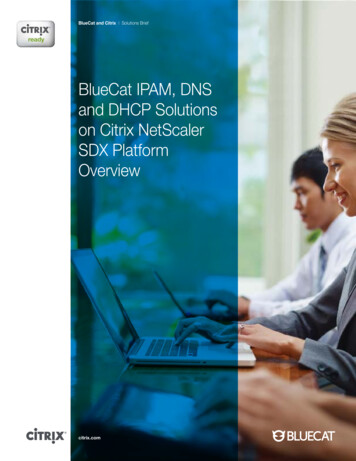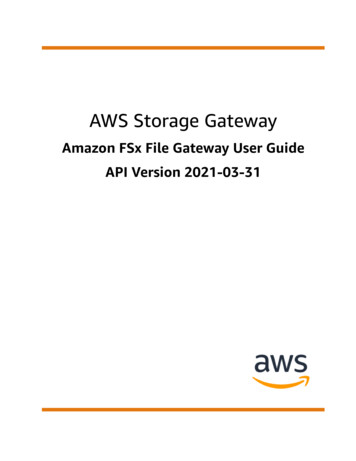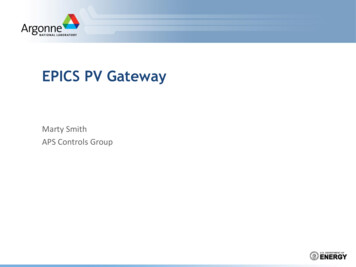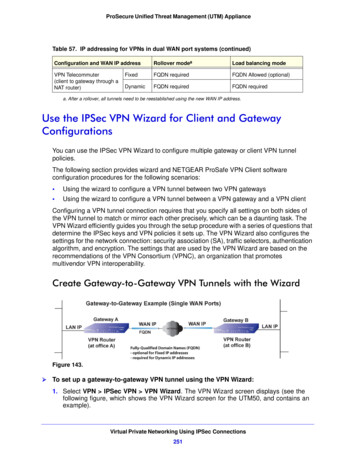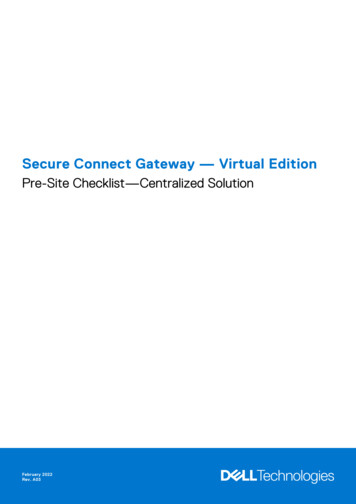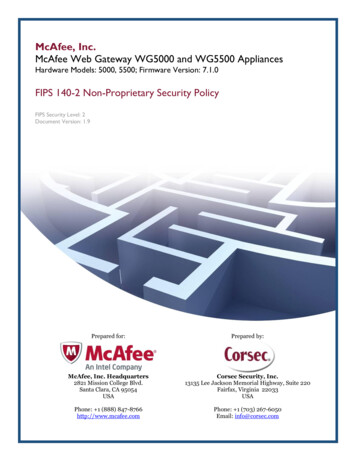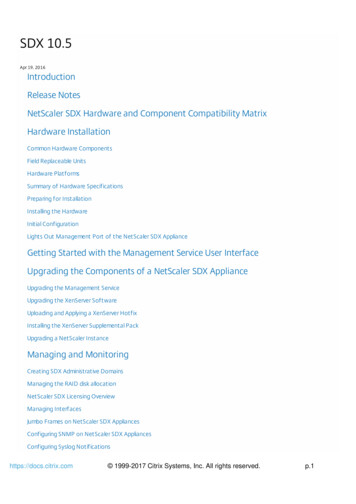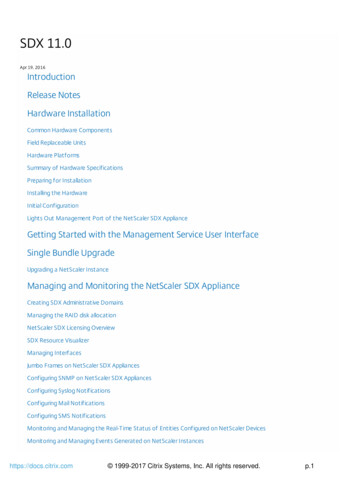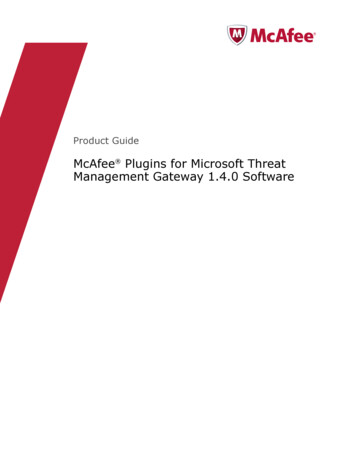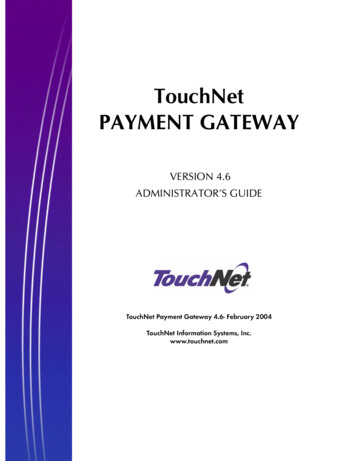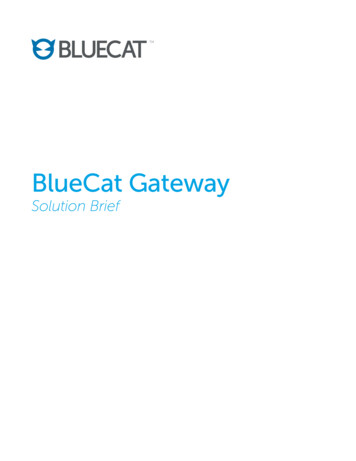
Transcription
BlueCat GatewaySolution Brief
BlueCat GatewayTable of ContentsIntroduction.3What is BlueCat Gateway .5Capabilities.7a) Consolidation.7b) Business-Specific APIs.7c) Leverage BlueCat Address Manager API. 8d) Certified Example Workflows. 8e) Change Management.9f) Easy Workflow Creation.9g) Built on Python. 10h) How Gateway is Deployed. 10BlueCat Gateway Use Cases . 11a) Cloud Resource Provisioning and Deallocation. 11b) Integration.12c) Self Service.14d) Zero-Touch Automation.16Conclusion.17www.bluecatnetworks.com2
BlueCat GatewayIntroductionAs organizations continue to adopt and implement digital transformation initiatives such asexpanding their footprint in the cloud or moving to an intent-based networking approach, rapid andreliable delivery of services has become table stakes. As IT professionals are tasked with enabling thebusiness with these new technologies and more aggressive SLAs (Service Level Agreements),automation has become central to contemporary digital transformation efforts. It enablesorganizations to define, orchestrate, and quickly implement complex business processes acrosssystems, people, partners and customers to drive greater value for customers.Organizations wishing to streamline their overall operations must include DNS processes in theirautomation efforts. Computerization minimizes the complexity of DNS configuration and reducesthe risk of human error while improving productivity. Non-expert users can thus rapidly makechanges to historically complex technology without causing DNS failures that could lead to majorbusiness disruptions.Nonetheless, most enterprise DNS operations remain largely manual.BlueCat Gateway is a Web application that modernizes DNS operations by providing a platform fordeveloping and deploying automated modular workflows. This platform simplifies DNSconfiguration tasks, speeds development, and gives end users self-service access to DNS serviceswhile reducing training requirements, lowering the risk of DNS configuration errors, and deliveringthe flexibility to meet organizations’ unique requirements.This white paper details the capabilities BlueCat Gateway offers developers and end users. It also describeskey use cases, including automated cloud provisioning, integration with existing change managementsystems, end-user self service, and zero-touch automation for automating back-end functions.Automation is Integral to Enterprise Transformation and GrowthOrganizations are increasingly turning to digital transformation to drive change across theenterprise. Digital transformation initiatives that allow organizations to better connect withcustomers and deliver greater value depend on the deployment of innovative technologies.But even as IT organizations are tasked with advancing the business using new technologies, theymust also meet growing demand for mainstream services. For example, over the past 10 years, Wi-Fiservice has gone from being a nice-to-have to a must-have for virtually every user. Similarly,companies have evolved from provisioning virtual machines (VMs) once for use in a static mannerto asking IT to continually spin up and spin down VMs to optimize compute. But that’s justscratching the surface. A flood of new technologies have emerged to significantly speed the deliveryof applications, services and compute. Containers, microservices, Kubernetes, and powerful newautomation frameworks like Ansible and Puppet have fundamentally changed the speed of businessand IT management.www.bluecatnetworks.com3
BlueCat GatewayMeeting these ever growing business demands requires IT organizations to operate more efficiently.IT organizations are thus automating workflows, developing dynamic infrastructures that can bemodified quickly and cost effectively, and improving change management and governance.In the process, IT teams are transforming themselves into IT as a service (ITaaS) to deliver the right ITservices at the right time at the right level of service. IT organizations are offering self-serviceportals and providing service catalogs that identify, define and control services available to endusers and developers. And through the use of APIs, IT is empowering end users and developers toquickly link modularized services together to modify the infrastructure as necessary to meet userrequirements.DDI has been Left Out of Digital TransformationTraditional DDI operations, such as creating network zones and assigning the IP addresses neededto locate services and devices, however, have only just begun to realize the potential of automation.Users perform DNS tasks manually, use solutions that require deep knowledge of complex APIs tocreate automated workflows, or employ out-of-the-box solutions that provide inflexible, cannedworkflows that cannot be customized. As a result, organizations are unable to meet SLAs forcompleting even the most basic DNS related tasks or fully automate scores of IT operations thatdepend on DNS.The Need to Simplify and Automate DNS OperationsTo keep up with growing network and DNS environments, today’s organizations are looking to anAdaptive DNS approach to bring their DNS operations the same level of efficiency and automationas the rest of their IT operations. They want to minimize the complexity of DNS configuration byreducing the need for coding, thereby lowering the risk of mistakes at all skill levels and allowingnon-experts to get what they need without constantly turning to an expert. Rather than requiringnetwork and DNS administrators to perform the same tasks repeatedly through the AddressManager UI or direct API calls, organizations want to automate all everyday IPAM tasks and DNSoperations involved in standing up networks or adding new devices. At the same time, they want theflexibility to meet their unique infrastructure requirements.This requires smart Infrastructure as Code (IaC) solutions that incorporate domain knowledge toensure that requirements are met rather than demanding that IT teams manually translate businessrequirements into complex configurations. IaC solutions manage and provision IT resourcesthrough machine-readable definition files, rather than physical hardware configuration or interactiveconfiguration tools. The benefits of an IaC approach are many, including speed and simplicity indeploying infrastructure, consistency in configuration, development efficiency and risk minimization.www.bluecatnetworks.com4
BlueCat GatewayWhat is BlueCat GatewayBlueCat Gateway brings the efficiency organizations have come to expect from IT services using IaCcapabilities to DNS operations. Gateway is an extensible platform that allows you to take complex,resource-intensive, automated tasks and build cleaner and lighter implementations while enabling asimple, self-service focused environment. Simply put, Gateway enables users to provide theirorganization with a more simplified and self-service focused environment. It simplifies DNSconfiguration tasks and speeds development, while providing authentication/access control, reducingdeveloper and end user training requirements, and lowering the risk of DNS configuration errors.www.bluecatnetworks.com5
BlueCat GatewayA Modern Development Platform for Automating DNS OperationsUsing BlueCat Gateway, IT teams can: A utomate cloud provisioning—IT can automate the DNS services necessary to provision anddeallocate cloud resources, so they can respond to user requests instantly. Automated cloudprovisioning reduces bottlenecks in delivering cloud services that all too often result in shadowIT, where end users request services directly from the cloud vendor without IT’s knowledge.Shadow IT can lead to security risks and excessive costs that IT is unable to manage. I ntegrate with existing systems—Organizations can integrate BlueCat Gateway with almost anyapplication. Such integration allows them to, for example, use their ITSM (IT Service Management)solutions, such as ServiceNow, OpenStack or vRO, for change management and auditing even asthey automate DNS-related workflows. This integration gives IT greater visibility into any DNSrelated changes that occur. rovide self-service to end users—IT can provide end-users with web forms through a self Pservice portal that allows them to request services, such as device registration/onboarding orprovisioning/decommissioning a server, and use automated DNS workflows to fulfill theserequests. By automating request fulfillment, IT can instantly address end user service requestsand thereby more easily meet service level agreements (SLAs). eliver zero-touch automation—IT can automate backend functions, such as failover for a DBlueCat Address Manager, without human intervention.www.bluecatnetworks.com6
BlueCat GatewayCapabilitiesBlueCat Gateway brings together all the building blocks for automating enterprise DNS operations ina single, easy-to-learn, easy-to-use development environment using RESTful APIs that implementyour business logic. Key capabilities provided by this environment include: Consolidation A business logic layer T he ability to leverage the BlueCat Address Manager API B lueCat Certified Example DNS Workflows hange management C E asy workflow creation S upport for Pythona) ConsolidationBlueCat Gateway consolidates all the business logic necessary to set up DNS for a resource, such asa network or device. It thereby allows IT to minimize the number of scripts the organization has andcentralize the remaining scripts.Typically, IT must perform a number of operations to assign DNS resources, such as determining theavailable networks or making API calls. BlueCat Gateway can bundle all the necessary APIs togetherinto a sophisticated service layer rather than requiring IT to write an application that makes separateAPI calls. This service layer can then be integrated into an end-to-end workflow.For instance, IT might create a form in BlueCat Gateway that, when filled out and submitted to auser, initiates a workflow that configures BlueCat Address Manager (BAM) and other systems. IT hasthe option to expose this workflow as a service. If IT creates a “Get IP” service, other applicationsthat need this service can make a single call and the service will provide the necessary IP address.b) Business-Specific APIsWhen organizations want to automate the delivery of cloud compute services, they need to performmany activities in addition to those related to DNS. BlueCat Gateway gives organizations a singlemodern automation platform to directly consume business-specific APIs that completely encapsulatethird-party vendor or BlueCat-specific implementation details, allowing them to perform thesefunctions. If aspects of the cloud compute environment change, IT needs only to make changes tobusiness process workflows that contain both DNS and related processes in one place.www.bluecatnetworks.com7
BlueCat Gatewayc) Leverage BlueCat Address Manager APIBlueCat Address Manager (BAM) is an IPAM solution that consolidates a wealth of data about everydevice and connection to a network. It then enables other network systems to easily consume thisdata to gain insight and make better decisions about network management, capacity planning andsecurity. BAM isolates users from the complexity of managing and configuring IP addressprovisioning and core services by wrapping multiple low-level API calls to the IP AddressManagement (IPAM) system into a single service call.The BlueCat API provides the interface that network IT departments need to make automated,process-compliant changes to IP and DNS configurations while retaining complete visibility andcontrol over IPAM data. The unified standards-based API set allows them to access all elements of theBlueCat solution so they can integrate with infrastructure solutions from leading commercial vendorsincluding VMware, IBM, HP, and BMC. BlueCat Connectors target the common network-relatedapplications that interact with IPAM – from orchestration and provisioning to event management.d) Certified Example WorkflowsBlueCat makes available on GitHub a library of Certified Example Workflows for tasks such as addinga host record, alias record, text record, or IP address. BlueCat developed and tested these workflowsto demonstrate the kinds of workflows that one can build for BlueCat Gateway. While theseworkflows are production ready, they also serve as templates that IT can modify and extend to fitthe organization’s needs. Rather than coding a workflow from scratch, IT can simply pull theworkflows from GitHub into BlueCat Gateway and then make necessary changes.Visit BlueCat’s GitHub repository at com8
BlueCat GatewayBlueCat has productized the maintenance of this library to ensure that each library remains up to date.It also guarantees that libraries comply with standards and conventions to simplify learning and use.Any customer can check out the code from the libraries, make modifications, and check the codeback in. Or they can create their own workflows and add them to the libraries. A community ofcustomers can innovate and contribute to an ever growing library of workflows, for the benefit of all.e) Change ManagementInput/export capabilities within BlueCat Gateway allow organizations to build, verify, and validatemodules in a test environment and then easily promote them to a production environment. Thismodular approach simplifies change management and enables users who are not highly technical toroll out code once it’s been developed.f) Easy Workflow CreationBlueCat Gateway makes it fast and easy to build self-service web forms that integrate with BAM APIsand workflows. IT can give these forms to end users to allow them to initiate a request that isfulfilled with an automated DNS workflow, for example, for device ng servers, user creation/management, or bulk processing.www.bluecatnetworks.com9
BlueCat GatewayUsing self-service web templates, IT can offer an intuitive interface that eliminates the need to trainend users on highly technical processes while preventing them from making mistakes, such asaccidently pressing delete instead of deploy.The templates can incorporate the following: Widgets – As IT develops forms, they can load easily configurable “widgets” to perform tasks.For example, if IT wants to enable a user to select a configuration, view and zone, they canemploy packaged widgets for each operation. Widgets can be dynamically populated as theuser fills in each field. Full customizability – The UI allows IT to fully customize the look and feel of web forms. Forexample, users can choose their desired color scheme or add a company logo. Permissions – The BlueCat Gateway web form framework enables IT to set role-basedpermissions. Administrator permissions give developers full access to developer/administratorcapabilities. User-level permissions can prevent access to specified capabilities. Thesepermissions allow non-technical users to fill out and submit a form to request services whilepreventing them from accessing capabilities that could potentially damage the system.g) Built on PythonBlueCat Gateway is based on Python, which has become the language of choice for networkautomation. Because Python is relatively easy to learn compared to other programming languages,its adoption has grown rapidly in recent years.The open source nature of Python means nearly anyone can learn how to create a workflow andnothing is hidden behind proprietary implementations. This creates a flexible base which can be builtupon to create any solution necessary. If you can imagine it, you can build it!h) How Gateway is DeployedRequestLayerREST over HTTP(s)TransportLayerLoadBalancerREST over waySOAP over ManagerActiveNodeAddressManagerPassiveNodeBlueCat recommended deployment approachwww.bluecatnetworks.com10
BlueCat GatewayBlueCat Gateway Use CasesBlueCat Gateway simplifies the assignment of DNS within a number of use cases. Among the mostpopular use cases are rapid provisioning and deallocation of cloud resources, integration, end-userself service, and zero-touch automation.a) Cloud Resource Provisioning and DeallocationToday, organizations are increasingly extending their on-premises systems by deploying cloudresources. Business users have come to expect that these cloud resources will be available instantly.But providing the necessary DNS services has become a bottleneck, often taking a VM admin orDNS expert weeks as they navigate deployment windows and approval processes.When business users encounter such delays, they often respond by purchasing third-party cloudservices through their expense accounts. While cloud subscriptions free business users from ITcontrols and restrictions, they lead to the problem of shadow IT, where individuals across theorganization subscribe to a cloud resources without IT knowledge or oversight. Shadow IT causessecurity risks as users create holes in the firewall to access cloud systems from on-premisessolutions, problems due to incompatible applications, and high costs for cloud services.BlueCat Gateway allows organizations to automate the allocation of DNS services by enablingorganizations to extend Adaptive DNS systems into the cloud, just as they would to a remotephysical data center. IT can add resources instantly to meet customer expectations, reducing therisk that users will subscribe to shadow cloud resources. This automation can extend to thecreation and management of entirely new virtual private clouds, subnets, and associated DNS zones.In addition, when organizations use BlueCat Gateway to provision cloud resources they gain theability to manage all their DNS in one central location. Even if the third-party cloud provider doesn’tallow them to manage the DNS, the integration provides a central view into what DNS has beencreated.Another concern with cloud resources is that IP/Connectivity for the cloud is extremely expensive asare the resources necessary to run these services continuously. Moreover, IP addresses that are nolonger in active use can cause clutter. Over time, organizations can build up so much bloat thatthey don’t know which IP addresses they are or aren’t using. Thus, when an organization is finishedusing cloud resources, it pays to deallocate that compute and associated IP addresses.Deallocating resources efficiently takes coordination and automation. Additionally, IT organizationsneed audit trails to recreate the resources if necessary. IT organizations can use BlueCat Gateway toautomate and track the cloud deallocation process. Timely deallocation can save thousands to tensof thousands of dollars each month. Deallocation gives IT greater visibility into what resources areavailable. It also reduces errors and outages caused by guessing whether a machine is in use oreliminates the need to ask everyone in the organization whether they are still using it.www.bluecatnetworks.com11
BlueCat GatewayExample: Cloud Deployment Challenge: An organization wanted to allow corporate cloud users to quickly allocate anddeallocate compute instances in the cloud, give IT instant visibility into DNS and accounting ofthese systems, and quickly extend its on-premises environment to the cloud through bidirectional name resolution. Resolution: BlueCat Gateway enables companies to extend their Adaptive DNS system into thecloud just as they would to a physical remote datacenter, providing instant visibility and bidirectional resolution.Client-drivenQuery on requestProactively, continuouslysynchronizingDNS -premClientClientOn-premClientBeyond these core use cases, BlueCat enables further automation of cloud requests, including thecreation and management of entirely new VPCs, subnets, and associated DNS zones right from thecompany’s enterprise ticketing system.b) IntegrationMost organizations have unique requirements that make a one-size-fits-all solution less thanoptimal. BlueCat Gateway enables customers to integrate with almost any application through ourcomplete set of open source APIs, using REST or other endpoints. We also provide sampleintegration workflows on GitHub that customers can modify for their own use case.One common use case for integration is ITSM. Companies today are looking to ensure changecontrol for everything that occurs in their environment. Whenever engineers introduce any change,it needs to be logged somewhere. As a result, change management solutions such as ServiceNowand Remedy are playing an increasing role in IT environments. Many companies want to use thesechange control solutions to keep tabs on their DNS and IPAM activities as well.BlueCat Gateway allows organizations to integrate DNS workflows with change control solutions.www.bluecatnetworks.com12
BlueCat GatewayFor example, they may create a web form in BlueCat Gateway to submit a request for an IP addressor to add a printer to the network. Filling out the form triggers ServiceNow to automatically open aticket, track any changes that occur during the back-end workflow, and then close the ticket.Organizations can perform this integration in one of two ways: They can use BlueCat Gateway webforms as the front end to call ServiceNow (or another application) to create a trouble ticket. BlueCatGateway tracks tickets created in the UDF (User Defined Fields) of BAM. If someone wants to referto the ticket, they simply use BlueCat Gateway to view the UDF in the BAM record to find the ticketnumber associated with the ServiceNow record. Alternatively, organizations can enable the ITSMsolution to call BlueCat APIs, so BlueCat services can be used within ITSM workflows.By integrating BlueCat Gateway with change management solutions, organizations benefit from acomprehensive audit trail. As the workflows automate and accelerate request fulfillment, thechange management solution keeps track of who fulfilled each request and what they did.Organizations gain visibility into changes made, which is useful during an audit or for regulatorycompliance. At the same time, end users can continue to employ their accustomed front end,eliminating the need for additional training.Example: IP Space Management and Visibility Challenge: A multinational professional services network had an IP space managed outside ofBAM and lacked visibility into that space. Resolution: BlueCat created a method to push data into BAM for viewing access only.Example: Single Source Visibility Challenge: Lack of visibility into an IP space managed outside of Address Manager. Resolution: BlueCat created a method to push data into BAM, giving a single source of data forthe entire businesses IP space.www.bluecatnetworks.com13
BlueCat GatewayExample: ServiceNow Challenge: Users faced a lengthy process for requesting approvals for new services. When theuser made a request, the administrator would have to manually verify the validity of the requestand then create the service. Resolution: BlueCat automated the workflows that ServiceNow uses to make requests forapprovals. Administrators now send requests to BlueCat Gateway, which handles approvallogistics. As a result, they know that submitted data is valid and can be approved ssManagerAddressManagerc) Self ServiceWhen users need an IP address for a server or printer, they typically must ask an administrator toprovision it for them. This task requires considerable manual effort and takes time away fromstrategic initiatives.To improve efficiency and enable IT to devote itself to innovation, many organizations want toenable end users to submit requests themselves and automate their fulfillment. But many currentsystems are too technical for typical end users. For example, when requesting an IP address or ahost record, end users must know which network and zone to put the host record in, somethingthey’re unlikely to be aware of.With BlueCat Gateway, IT organizations can make it easy for a non-technical user to provision theirown services without having to learn complicated programming. IT simply creates self-service formsthat end users can employ to kick off workflows that automate back end processes related to DNSprovisioning. These workflows integrate with other systems that expose APIs to complete end-toend processes that extend beyond DNS. For example, these workflows can create tickets within achange management system or logging solution such as Splunk. The user simply goes to a self-www.bluecatnetworks.com14
BlueCat Gatewayservice portal, uses a form to make a request, and a script runs that completes the provisioning inthe background. IT can incorporate permissions to prevent end users from changing anythingthey’re not supposed to.As developers create these workflows, they can take advantage of the fact that BlueCat Gateway isprogrammer friendly. Programmers create workflows using pre-built components that easilyintegrate with any other service that exposes its APIs.By creating self service workflows, organizations see benefits that include: Eliminating the human error that comes from manual provisioning. Such errors can keep thedevice from being onboarded properly and mean that IT must spend time troubleshooting whatwent wrong. Saving time and resources. Tasks that once took days, now take minutes. Companies can nowrespond to market demands and deliver services to end users more quickly. Creating comprehensive logs to trace what was done. If something goes wrong, IT can seewhat was happening at the time to speed troubleshooting. Full audit trails improve regulatorycompliance. Enforcing good processes. By using workflows to enforce standards, organizations can ensurethat data going into the system is of the highest quality. Following standards reduces the needfor administrators to oversee the process and to be involved with the creation of every record,allowing them to concentrate on more strategic issues.Example: Record Creation Challenge: Users who want to create DNS resource records require extensive training. Forexample, if users wish to create Host (A) Records, they need training in DNS and in AddressManager. Resolution: BlueCat Gateway simplifies the process of creating A records, plus other resourcerecords, by reducing the complexity of IPAM and enabling access to it from an intuitive webform suitable for users of any skill level.Example: Customized Reporting Challenge: Some companies must follow strict regulations and produce extremely complexreports involving multiple cross sections of data. Resolution: BlueCat brings together disparate sources of data from IPAM, DNS Edge,www.bluecatnetworks.com15
BlueCat GatewayServiceNow and so on. With minimal effort, you can then automate the process of extracting,sorting and curating datasets to create more comprehensive customized reports.Example: Bulk Uploads Challenge: Companies must add, modify, or delete large numbers of IP addresses, host recordsor other objects. Resolution: Rather than manually writing scripts, organizations can use BlueCat to createcustom bulk uploads that add, modify, and delete many IP addresses, host records, and so on,at once, saving time.d) Zero-Touch AutomationZero-touch integration is used when IT wants something to happen on the back end without theneed for human intervention. For example, IT might want the system to recognize when a BAM goesdown and then automatically failover to a secondary address manager while generating theappropriate logs and fixing the problem automatically. Zero touch automation makes the failoverfaster and easier. It also reduces resource load on the team by allowing the organization to preventproblems without constant human monitoring.Example: Orchestration Challenge: Many companies need to track complex BAM data, including resource locations,ownership, groups, and tags for thousands of subnets. Resolution: BlueCat helped companies expose service layers to enable orchestration. Wereduced BAM complexity by exposing services that bundle multiple API calls.Example: Automating Manual Tasks Challenge: The customer faced tedious manual processes for op
BlueCat Gateway www.bluecatnetworks.com 4 Meeting these ever growing business demands requires IT organizations to operate more efficiently. IT organizations are thus automating workflows, developing dynamic infrastructures that can be
